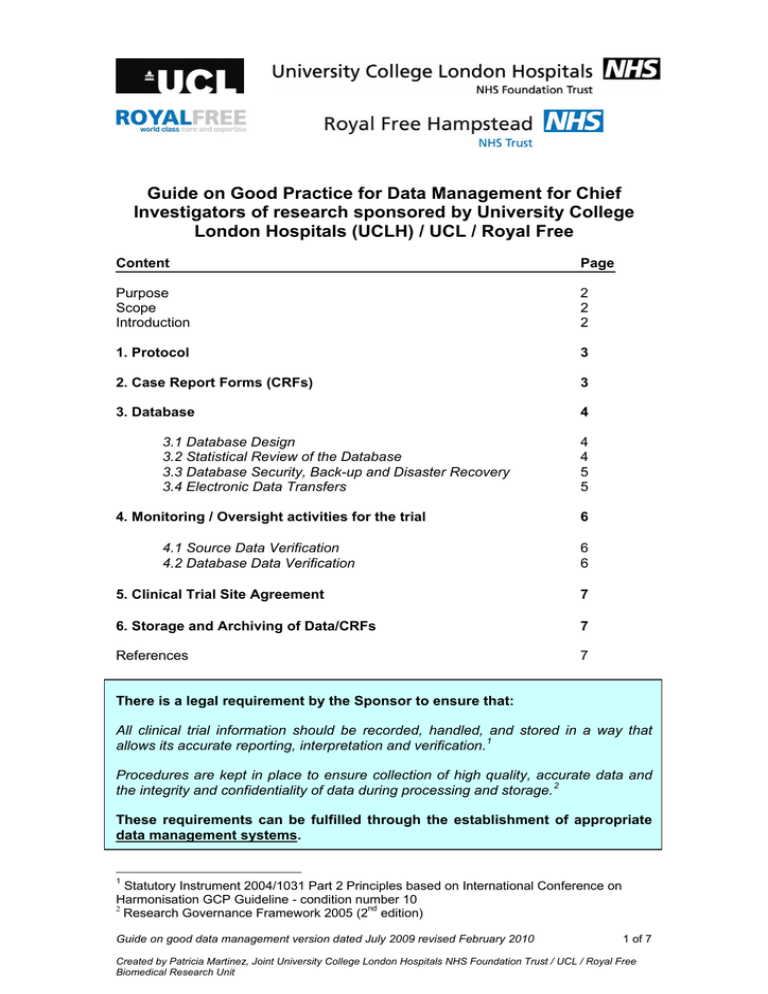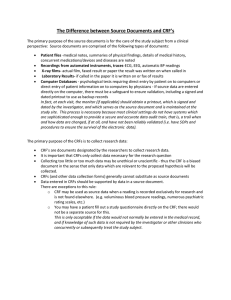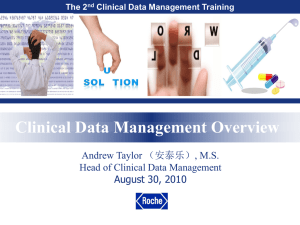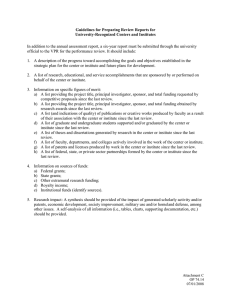Guide on Good Practice for Data Management for Chief
advertisement

Guide on Good Practice for Data Management for Chief Investigators of research sponsored by University College London Hospitals (UCLH) / UCL / Royal Free Content Page Purpose Scope Introduction 2 2 2 1. Protocol 3 2. Case Report Forms (CRFs) 3 3. Database 4 3.1 Database Design 3.2 Statistical Review of the Database 3.3 Database Security, Back-up and Disaster Recovery 3.4 Electronic Data Transfers 4. Monitoring / Oversight activities for the trial 4.1 Source Data Verification 4.2 Database Data Verification 4 4 5 5 6 6 6 5. Clinical Trial Site Agreement 7 6. Storage and Archiving of Data/CRFs 7 References 7 There is a legal requirement by the Sponsor to ensure that: All clinical trial information should be recorded, handled, and stored in a way that allows its accurate reporting, interpretation and verification. 1 Procedures are kept in place to ensure collection of high quality, accurate data and the integrity and confidentiality of data during processing and storage. 2 These requirements can be fulfilled through the establishment of appropriate data management systems. 1 Statutory Instrument 2004/1031 Part 2 Principles based on International Conference on Harmonisation GCP Guideline - condition number 10 2 Research Governance Framework 2005 (2nd edition) Guide on good data management version dated July 2009 revised February 2010 1 of 7 Created by Patricia Martinez, Joint University College London Hospitals NHS Foundation Trust / UCL / Royal Free Biomedical Research Unit Purpose This document outlines recommended best practice for effective data management. It is important to take into account trial design, aims and available resources when addressing issues of data management according to research governance requirements of Good Clinical Practice and the Research Governance Framework. It provides a source of reference when developing a clinical trial of investigational medicinal product (CTIMP), as well as all other types of research studies. Scope This guide relates to the principles of good clinical practice to be used for data management of all research sponsored by UCLH, UCL and the Royal Free including both CTIMPs and all other research. As a result, it is possible to ensure that data generated, documented, recorded and reported is in compliance with Good Clinical Practice and the Research Governance Framework. Data management must be considered at all stages of trial conduct: • • • • Trial design / Set-up Active trial management Analysis of results Closure of Trial Plans for data management need to be considered when developing the following trial documents and plans: • • • • • • Protocol Case report forms (CRF) Database construction Monitoring data quality / Oversight activities for the trial Clinical Trial Site Agreement (for multicentre studies outlining both Sponsor and host organisation’s responsibilities.) Storage and Archiving of Data/CRFs Introduction This guide is to be used to ensure the minimum requirements of data management are fulfilled until a more detailed Standard Operating Procedure (SOP) is developed in line with the established Clinical Trials Unit requirements. THE JOINT BIOMEDICAL RESEARCH UNIT RECOMMENDS THE USE OF MICROSOFT ACCESS AS A SUITABLE SOFTWARE FOR DEVELOPING A RESEARCH DATABASE WHICH IS AVAILABLE FREE OF CHARGE ON UNIVERSITY COLLEGE LONDON, UCLH AND ROYAL FREE DESKTOP. Guide on good data management version dated July 2009 revised February 2010 2 of 7 Created by Patricia Martinez, Joint University College London Hospitals NHS Foundation Trust / UCL / Royal Free Biomedical Research Unit 1. Protocol Data management details should be outlined within the protocol with reference to the Sponsor’s Standard Operating Procedure (SOP) for writing a CTIMP Protocol. The protocol should include section(s) to include information on the following: • • • • • • • • • Description of procedures for data collection. The protocol must specify which variables (original, efficacy and safety data) are to be recorded and collected in line with the trial research objectives to enable to assess all of the trials end point(s) (primary and secondary). Description of what data (including safety data) are collected and recorded within a case report form (CRF), and to provide instructions on CRF completion. Description of database software (e.g. MACRO, Access) used to capture the data and for randomisation. Excel is not a database. Details on methodology implemented to ensure data validity and quality (e.g. double entry, cross validation etc), consistency in data recording and changes made by authorised individuals. Reference to the delegation log with regards to the responsibilities delegated by the Chief Investigator / Principal Investigator to individuals or state those responsible for data collection; recording and reporting data / SAEs / AEs; data verification; authorised individuals with access to the database; database entry modification; identified custodian(s) of the database; and named responsible individuals for ensuring data quality. Adherence to the Data Protection Act 1998 Outline of the duration and location of record / database retention. Description of how data will be stored, how security would be ensured and whether data will be transferred. If data are to be transferred, describe the secure method of transfer. Refer to any relevant policies, SOPs or study specific procedures. Plans for archiving of trial data. 2. Case Report Form (CRFs) A CRF is designed to record all information required by the protocol on each trial subject and contributed towards the data to be analysed for the trial in order to answer the protocol aims and objectives. It is essential to ensure that data required by the protocol are reported accurately on CRFs and are consistent with the source documents e.g. medical notes, lab notes, x-rays, scans. CRFs are not source data but a tool for recording source data. CRFs should be designed and completed with reference to the Joint Unit Guide for the Design, Use and Completion of Paper Case Report Forms (CRFs). CRFs are designed to capture the required data across all trial sites for every patient consented to take part and eligible under the protocol specific criteria. The completion of CRFs should be signed off by the Chief Investigator or delegated authorised individual (Principal Investigator) as outlined in the delegation log. It is important to provide a blank hard copy of the CRF for review by the Sponsor as well as to include a copy within the trial master file. An annotated copy should also be filed with reference to the relevant corresponding fields of the trial database. Any changes to the CRF should be notified to the Sponsor throughout the conduct of the trial and consideration given towards reasons for any change(s). Changes to the CRF may be considered as a substantial amendment to the trial protocol. Guide on good data management version dated July 2009 revised February 2010 3 of 7 Created by Patricia Martinez, Joint University College London Hospitals NHS Foundation Trust / UCL / Royal Free Biomedical Research Unit 3. Database The database used for the trial should be designed in conjunction with the case report forms so that the data captured are complete, accurate, reliable and consistent. Appropriate software should be used in developing/designing a database to ensure: • Ease of use with appropriately controlled access • Prevention of duplicate entries • Field validations, where appropriate • Consistent data coding (e.g. MedDRA coding 3 or other convention which is developed at the start of the study) • Consistent and accurate downloads for analyses • Full audit trail possible of data entered and any changes made. • Regular back-ups The database should be designed, validated, managed and used to capture the trial data, for data analysis to obtain the primary and secondary end points, as outlined in the study protocol. It can also be used to monitor the trial with regards to the progress towards the outlined analyses within the protocol. 3.1 Database Design Database design should be documented. Where a database has been developed it is important to document details on the development of the system for data entry and data analysis including database preparation, installation of the software, test runs, training, security checks, periodic reviews to confirm data integrity and compliance with operational specification. A key part of database design is database validation to provide brief descriptions of the validation strategies and activities. • • To outline test procedures and document validation results with written assurance that the system is fit for purpose. To identify key personnel and their responsibilities as part of the validation process. 3.2 Statistical review of the Database The designated statistician should receive a full and dated download of the database, with a complete and accurate dataset used for analysis. This should be retained separately from the live database to allow reproducible analyses. This is sometimes referred to as ‘database lock.’ It is a controlled procedure that freezes the data in a particular format securing the trial data and preventing further changes. There is a requirement to ensure all the trial data have been received, verified, fully coded and cleaned for analysis with all queries resolved before locking 3 Medical Dictionary for Regulatory Activities (MedDRA) clinically validated medical terminology used for Adverse Event reporting Guide on good data management version dated July 2009 revised February 2010 4 of 7 Created by Patricia Martinez, Joint University College London Hospitals NHS Foundation Trust / UCL / Royal Free Biomedical Research Unit the database for further analyses. Unlocking of the database should be strictly controlled and documented. 3.3 Database Security, Back-up and Disaster Recovery All trial data are governed by Data Protection Act 1998, the University and Trust Information Governance Policy requirements and must be handled accordingly at all times. It is extremely important to take into consideration the following when storing data: • • • • To ensure that for electronically stored trial data (lap top, PC hard drive, server) there is routine and adequate back up provided. To ensure that data are anonymised by using patient trial numbers where possible and that the database as well as the lap top and/or PC are password protected. To document when the database is backed up; where it is stored; how it can be accessed if necessary; and who has access to the back-up. To outline the disaster recovery plan. Whether there is a hard copy or CDROM of the data stored in a secure separate location (e.g. fireproof cabinet). It is very important to maintain procedures and records related to access. There should be clearly defined responsibilities for database security such as: • • • Security strategy and delegation Management and delegation of privileges Levels of access for users and for infrastructure (firewall, backup, re-boot) There should be procedures in place for recovery of the database following a breakdown, routine back up and disaster recovery. These entries should be recorded using a log. 3.4 Electronic Data Transfers Where data are transferred electronically it should be in accordance with the Data Protection Act 1998 as well as the University and Trust Information Governance Policy. There should be a documented record of data transfers and measures in place for the recovery of original information after transfer. Guide on good data management version dated July 2009 revised February 2010 5 of 7 Created by Patricia Martinez, Joint University College London Hospitals NHS Foundation Trust / UCL / Royal Free Biomedical Research Unit 4. Monitoring / Oversight activities for the trial The Sponsor’s risk assessment of trials can establish the level of monitoring required giving rise to an overall trial monitoring plan. Monitoring should be conducted by the Sponsor according to the Joint Unit’s monitoring programme for CTIMPs sponsored by UCL. In order for the Sponsor to conduct on-site monitoring it is the responsibility of the Chief Investigator and Principal Investigator to ensure that the data recorded is both accurate and verifiable. 4.1 Source Data Verification Source data and CRF data should be checked as being accurate, complete, reliable and consistent before it is entered onto the database by individuals delegated the responsibility as outlined in the delegation log. There are several steps to this process as outlined below: • • • • Data should be verified at the beginning as part of the screening process, with regards to the relevant baseline investigation data prior to randomisation, to ensure patients fulfil the inclusion/exclusion criteria. Determining whether all adverse events (AEs) are appropriately reported and recorded as outlined in the protocol. Where queries are raised with regards to CRF entries, that these are corrected within a suitable time-frame. The CRF should be checked for errors before being deemed as complete and authorised as such before any trial analysis. This process should be documented by each Principal Investigator on site. The delegation/monitoring log should outline a list of individuals authorised for data entry and verification of CRF entries against source data. The monitor should ensure that appropriate corrections, additions, or deletions are made, dated, explained (if necessary), and initialled by the investigator or by a member of the investigator's trial staff who is authorised to initial CRF changes for the investigator. It may be appropriate to develop a CRF query form to capture data that is missing, inconsistent or illegible, and also develop of a system to ensure these queries are processed and addressed to ensure completion of the data. 4.2 Database Data Verification Procedures should be in place to ensure that data entered onto the database are correct and are verified as such. Procedures should also be in place to record changes in database entries (insert, update, delete, error). There are databases with software that have the function to record changes in entries as part of an audit trail. Guide on good data management version dated July 2009 revised February 2010 6 of 7 Created by Patricia Martinez, Joint University College London Hospitals NHS Foundation Trust / UCL / Royal Free Biomedical Research Unit 5. Clinical Trial Site Agreement For multicentre trials, the standard UCL sponsored clinical trial site agreement template outlines that data are collected and provided to the Sponsor within appropriate timeframes as required by the protocol. 6. Storage and Archiving of Data/CRFs There is a requirement to abide by the relevant regulatory requirements, Trust and University Policy with regards to the storage and archiving of data and CRFs. References Medicines for Human Use (Clinical Trials) Regulations 2004 Statutory Instrument 2004/1031 http://www.opsi.gov.uk/si/si2004/uksi_20041031_en.pdf Medicines for Human Use (Clinical Trials) Amendment Regulations 2006 Statutory Instrument 2006/1928 http://www.opsi.gov.uk/si/si2006/uksi_20061928_en.pdf European Clinical Research Infrastructures Network (ECRIN) -Transnational Working Groups (TWG) Deliverable D10 GCP-compliant data management in multinational clinical trials (version 1 dated 15 September 2008) http://www.ecrin.org/index.php?id=148 European Commission Guidance documents containing the common provisions on the conduct of GCP inspections by competent authorities of the different member states Annex IV To guidance for the conduct of good clinical practice inspections Sponsor and CRO (28 May 2008) http://ec.europa.eu/enterprise/pharmaceuticals/eudralex/vol10/chap4/annex_iv_to_guidance_for_the_conduct_of_gcp_inspections__sponsor_and_cro.pdf Pharmaceutical Inspection Convention / Pharmaceutical Inspection Co-operation Scheme Guidance (PIC/S) on Good Practices for Computerised Systems in Regulated “GXP” Environments (25 September 2007) http://www.picscheme.org/publication.php?id=8 The Department of Health’s Research Governance Framework for Health and Social Care 2005 (2nd edition) http://www.dh.gov.uk/prod_consum_dh/groups/dh_digitalassets/@dh/@en/document s/digitalasset/dh_4122427.pdf Guide on good data management version dated July 2009 revised February 2010 7 of 7 Created by Patricia Martinez, Joint University College London Hospitals NHS Foundation Trust / UCL / Royal Free Biomedical Research Unit



